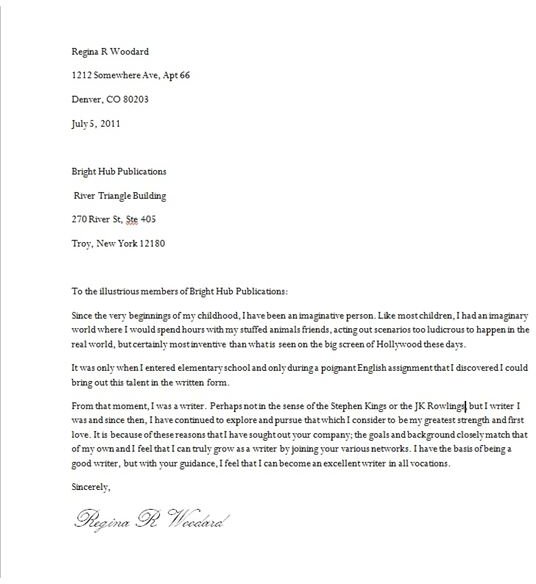Using an Letter of Introduction for Your Design Portfolio
Getting The Job You Want
Freelancers don’t need to be restricted to a 9-5 work schedule; we can work 5am until 10am or even midnight till 9am. We can work in our jammy jams or in the coffee shop around the corner. And we can pick and choose the clients we want. The life we lead is pretty sweet.
The life of a freelancer can be bliss, but we do need to put our best foot forward when it comes to gaining lucrative work and contracts from businesses and organizations. In most cases, this means sending out our portfolios. Portfolios are like one large résumé that helps companies view achievements and work that we’ve done in the past for others, which helps them decide if we’re the type of freelancer they are looking for.
While many freelancers may already have a portfolio put together, some may forget an important part of that process - that of the letter of introduction. What is this letter? Where does it go? And why do you need a letter of introduction for a portfolio anyway?
What Is A Letter of Introduction?
As mentioned, a portfolio is like a one large
résumé - usually, they will include your actual résumé, three accomplishments that you’ve done for other businesses or companies, three letters of recommendations, the letter of introduction, and some of your interests and activities. Because portfolios aren’t necessarily for design work, some individuals may also include their school transcripts or college courses that are relevant to the work or company they are providing the portfolio for.
With technology a standard for most of us, you may find that putting up an online portfolio can be beneficial if you plan on working through online means or businesses. Even though many of us are using computers and the Internet in most cases, it’s still a good idea to have a hard bound copy of your portfolio, placed within a three ring binder with protective sheets to protect your work.
Now that you know a little more about a portfolio, let’s get down to the real question - what is a letter of introduction? Just as a portfolio is very much like a résumé, a letter of introduction is that résumé’s cover letter.
Within a letter of introduction, you specify why you’re interested in this particular business (or school) that you’ve chosen, what aspirations and goals you have for you career in general, what skills and abilities you possess that will not only help you in this career, but how it will help this particular company, and why you stand above the others who are also looking to be a part of this business or school.
Letter of Introduction Structure
Like a cover letter, a portfolio’s letter of introduction has the same structure - your contact information, the information of the business or school, the date, the bulk of the letter, and your signature at the bottom. The picture above is a sample letter of introduction which has the following -
- Your name and address
- The date
- The name and address of the business
- The body of the letter explaining aspirations, goals, a bit of background information, what about this company made you chose them, and why they should chose you.
- Your signature (can also be name and signature if using a hard copy version)
In terms of presenting this with your portfolio, you’ll want to discuss what it is you’ve got going on in this binder you’ve given them. As a desktop publisher, your letter of introduction should speak about the type design work you’ve done, what you consider your best work and why, as well as how your design skills are best suited to the work the company is looking for.
Just like a cover letter, you want to be professional, but you also want to make a connection with the hiring manager so they’ll, you know, hire you. This is easy to do if you’re in person, but when doing this via an online portfolio, you need to get a little more in depth about your work. Mention that you have repeat clients or that you have an eye for art deco and then explain why. But remember, this is only supposed to be one page, so only mention one or two pieces if you have a host of designs.
Letter of Introduction Position
Within a portfolio, the letter of introduction should be placed before your résumé, just as you would place a cover letter. When using a three ringed binder, prospective employers should be able to open the binder and see your letter of introduction as the first page (though you can also provide a table of contents or splash page at the beginning if you would like).
A letter of introduction can still be used even if you have an online portfolio. This could be done in two different ways - you can use the letter of introduction to point prospective clients to your portfolio if you’re responding to an online employment offer or you can have a modified letter of introduction on your portfolio page itself, welcoming those that have come to see the page. This type is more of a general letter, as you aren’t focused on a particular business or school, but you should explain any goals and aspirations, as well as how you can help businesses with their needs.
If using an online portfolio, be sure to include an About page, so that visitors to your portfolio can learn a little more about you.
References
Career Portfolio from Maine Career Advantage, https://www.ccd.me.edu/careerprep/career_portfolio.pdf
Letter of Introduction from Idea Consulting, https://www.ideasconsulting.com/dp/jenna/intro.htm
Image Credit: Letter of Introduction/author
